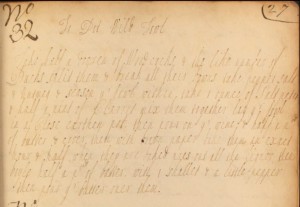This potted baked salmon is flavoured with cloves, mace and nutmeg: spices we’ve come to closely associate with the culinary world of our Unknown Ladies:

This potted salmon recipe from The Cookbook of Unknown Ladies produces a fish dish with distinctive 18th century flavours
To Pot Salmon
Take a side of salmon & take all the skin of & chop it very fine with half a pnd of fresh butter. Then take half an ounce of cloves & mace, a nutmeg, half an ounce of pepper, a large ounce of salt. So season yr fish and put it in to a small close pot and let it bake an hour & half exactly. Then strain all the liquor very dry from it & then cover it with drawn butter for your use.
The melted butter which is used to cover the fish would set upon cooling, sealing the potted salmon from the air. This way, the salmon could be kept in a cool place for several days: far longer than a fresh, untreated fish ever could.
The product of this recipe is a rich, buttery fish dish, which would work very well warmed up and spread on toast. Our Cooking Up History team have come across similar spice combinations many times now: in almond puddings, as well as in veal florentine and citrus dumplings. For some of them, cloves, mace and nutmeg ‘tasted of Christmas’. So here’s an idea: why not ditch the smoked salmon blinis and mackerel pâté at your Christmas party this year, and make 18th century style potted salmon the talking point of your festive table?



